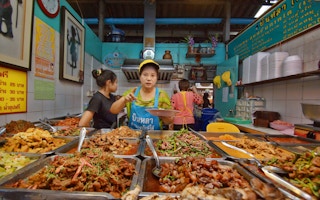The rise of meat-eating in Asia is used by economists as an indicator of the region’s growing prosperity. But a sobering new report suggests that investors should think twice before taking a bite out of a sector rife with environmental and social abuses.
Asia’s meat, seafood and dairy industries face a growing smorgasbord of sustainability risks, from food safety and the misuse of antibiotics to high levels of greenhouse gas emissions and animal mistreatment.
These risks threaten to curb financial returns in the sector, a report called Factory Farming in Asia: Assessing the investment risks from Singapore-based consultancy Asia Research and Engagement and investor network Farm Animal Investment Risk & Return (FAIRR) warns.
Asia’s appetite for meat is predicted to swell by 19 per cent between 2013 to 2025, according to the Organization for Economic Cooperation and Development data, as rising income levels make meat a more affordable source of protein for the region’s burgeoning middle classes.
But this growth will not necessarily mean a wholesome return for investors, thanks to five key concerns investors in Asia’s food sector.
Multinational food giants such as Yum! Brands, the owner of KFC and Pizza Hut, and burger giant McDonald’s have seen the image damage caused by food scares in China, with expired meat and food-borne diseases such as E. coli robbing brands of consumer trust. Meanwhile, the growing trend for healthier eating and the rising popularity of vegetarian and vegan diets, even in China, where 28 per cent of the world’s meat is consumed, could soon start to eat away at the popularity of meat on Asian dinner tables, the report predicts.
“
A failure to reform the Asian meat and dairy industries in areas like food safety, could spell a nasty bout of financial food poisoning for global investors.
Jeremy Coller, founder, FAIRR
Public health risks from the consumption of meat and fish pose the second biggest problem for potential investors, the report cautions. In particular, the overuse of antibiotics in livestock production has led to the growth of antibiotic-resistant bacteria in humans and animals, which could eventually make many common diseases such as malaria and tuberculosis untreatable. This would lead to 10 million human deaths a year by 2050.
Asia is set to increase antibiotic use in chicken and pigs by 129 per cent and 124 per cent, respectively, by 2030, even though the World Health Organization has declared the rise of antibiotic resistant superbugs to be “one of the biggest threats to global health, food security, and development today”.
Meanwhile, viral infections and livestock epidemics are increasing in frequency and severity. One example is the 35 million birds that were killed in South Korea last year as a result of bird flu.
The environmental footprint of the meat industry is another reason for investors to fret, the report points out. Even the least carbon-intensive meat - chicken - generates 65 times more emissions per calorie than legumes.
Regulators are starting to eye the polluting effects of the meat industry, for instance in New Zealand - one of the world’s largest milk producers - where the discharge of effluent from dairy farms is placing a strain on waterways, and in China, where livestock produces 243 million tonnes of faeces and 163 million tonnes of urine a year.
Food sector investors should also pay more attention to animal welfare issues in Asia, according to the report. A number of cases of animal cruelty in Vietnam, a major cattle exporter, have emerged to disrupt global meat supply chains in recent years.
The report highlights labour standards as the fifth major risk for investors. Thailand’s seafood industry is the most notable example of worker exploitation, with increased scrutiny of employment practices prompting companies such as Nestlé, the world’s biggest food and beverage firm, to rethink their supply chains.
While there are risks inherent in meat, fish, egg and dairy production in Asia, there are business opportunities in the emerging market for meat alternatives, the report argues. This market is currently concentrated in Europe and North America, with only 12 to 15 per cent of the meat alternatives sector in Asia. But the acquisition of meat substitute producer Quorn foods by Filipino food company Monde Nissin in 2015 is one encouraging sign for a sector predicted to grow to $5.2 billion by 2020.
In Southeast Asia, new product launches that make vegetarian claims increased by 140 per cent between 2012 and 2016, while new vegan product launches increased by 440 per cent over the same time period, the report pointed out.
“Far sighted investors are looking to alternative proteins for future growth, with the likes of Asian-owned Quorn growing 19 per cent in the first half of 2017,” said FAIRR founder Jeremy Coller.
He said in a statement that a failure to reform Asia’s meat and dairy industries on issues such as food safety “could spell a nasty bout of financial food poisoning for global investors.”
“Investors have a big appetite for Asia’s animal protein sector. But growth is driven by a boom in factory farming which tends to mean more emissions and more epidemics, abuse of antibiotics and abuse of labour. All risks to returns,” he said.
Coller pointed out that it is three years since McDonald’s and KFC faced a $10.8 billion loss of market capitalisation due to the expired meat scandal in China, “But lessons have not been learnt.”

















